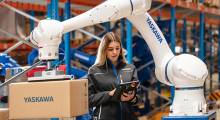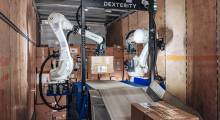COVID-19 shaping Digital Transformation
In some respects, the imperative to pursue Digital Transformation is even more urgent in light of the pandemic and its repercussions. Also, the crisis has significant implications for the way artificial intelligence (AI) - a core component of DT - is deployed in the supply chain domain.
Digital Transformation-derived flexibility gaining currency
The pandemic is testing the resilience of supply chains as never before, and the consequences for how supply chains are designed and operated will take years to play out. However, what is already clear is that DT will help to define what we mean by a resilient supply chain going forward.
Visibility is fundamental to resilience, and data is intrinsic to visibility. Companies that are relatively advanced in their DT journey are using end-to-end data to connect globally dispersed operations, and are achieving levels of visibility that are not available to less advanced enterprises.
DT also improves the ability of companies to flex with volatile markets and shifting demands. We have seen how powerful this can be as the pandemic has forced drastic changes in the corporate world. For example, manufacturers of autos and fashion apparel have pivoted to produce urgently needed medical and personal protective equipment.
Companies that can turn on a dime in this way have the flexibility and robustness needed to excel in highly changeable markets. DT imbues these qualities because it often requires companies to redesign processes from scratch. Also, they have to be adept at realigning the digital thread when introducing new products. The manufacturers that responded to demands created by the pandemic face this realignment challenge.
Unfortunately, companies that have only just started their DT journey will find it more difficult to achieve this level of flexibility. These enterprises will have to ramp up their efforts in response to market demands.
Moreover, DT lends itself to e-commerce and the service rigors of last-mile delivery. E-commerce has gained ground in the pandemic as stay-at-home consumers order more products online.
Another potential pandemic-related outcome is that DT will help companies to manage the uncertainties of global trade. The COVID-19 crisis is compounding the tensions that disrupted trade flows before the virus erupted. However, globalization will still be a potent force even when the pandemic subsides. For example, a single Apple iPhone is made up of parts sourced from 42 countries. Companies are redesigning their supply networks in response to changes in the global trade landscape. Digitalized supply chains will make it easier for them to switch from one model to another as government policies change.
Digital Transformation’s Impact on M&A activity
The fallout from COVID-19 is likely to include more mergers and acquisitions as the crisis increases the vulnerability of possible M&A targets. Here again, DT will play a defining role.
According to one study by MIT Sloan Management Review, only 17% of digital platforms survive the competitive dynamics of markets. These failures will weaken the companies involved and make them more attractive M&A targets. Enterprises that are relatively new to DT could also be tempting targets. Digital platforms require a period of maturation to capture the benefits of the expected network effects. However, even mature DT platforms will not be immune to M&A pressures. A robust digital platform could attract interest from increasingly aggressive market predators.
Pandemic puts a human face on Artificial Intelligence
The COVID-19 crisis has important implications for the application of AI in supply chains, especially with regard to how machines and humans work together in these projects.
Insightful research conducted with my colleagues from IE Business School in Madrid, Spain, looked at the importance of the machine/human interface to the success of AI projects. We developed a framework to help companies achieve the best balance between these two vital elements.
The framework is based on four scenarios. The fourth, called human-based AI, involves high-risk situations where humans have the final say in critical decision-making. The COVID-19 pandemic is such a situation.
While AI can analyze these types of disasters and provide valuable guidance, the coronavirus crisis is unique, and there is a lack of historical precedents that an AI algorithm can learn from. AI does not consider what happened 100 years go with the last pandemic. Hence, humans must make the final call.
This experience provides an essential lesson for the future: AI’s vast analytical power is not omnipotent, and that humans still represent a vital part of AI projects.
Digital gap reinforces digitalization
The race to harness DT in supply chains will widen the digital divide as the ranks of digitally literate companies becomes more polarized.
This trend was underway before COVID-19 cast a global shadow over businesses, but it will now accelerate, making the case for DT even more compelling.
Dr. Maria Jesus Saenz is director of MIT Digital Supply Chain Transformation Research and a research scientist at the MIT Center for Transportation & Logistics. She can be reached here.
With the impact of the COVID-19 pandemic on supply chains, it's time to explore the essential tools used in digital transformation with MITx Supply Chain Analytics online course.
MITx Supply Chain Management MicroMasters - Supply Chain Analytics
With the impact of the COVID-19 pandemic on supply chains, it's time to explore the essential tools used in digital transformation with MITx Supply Chain Analytics online course.
Related: MIT Center for Transportation & Logistics Coronavirus Response - Part Two
Supply Chain 24/7 Education Resource Center
Find the latest educational resources, degrees, and programs.
Visit: Supply Chain 24/7 Education Resource Center
Article topics
Email Sign Up

















